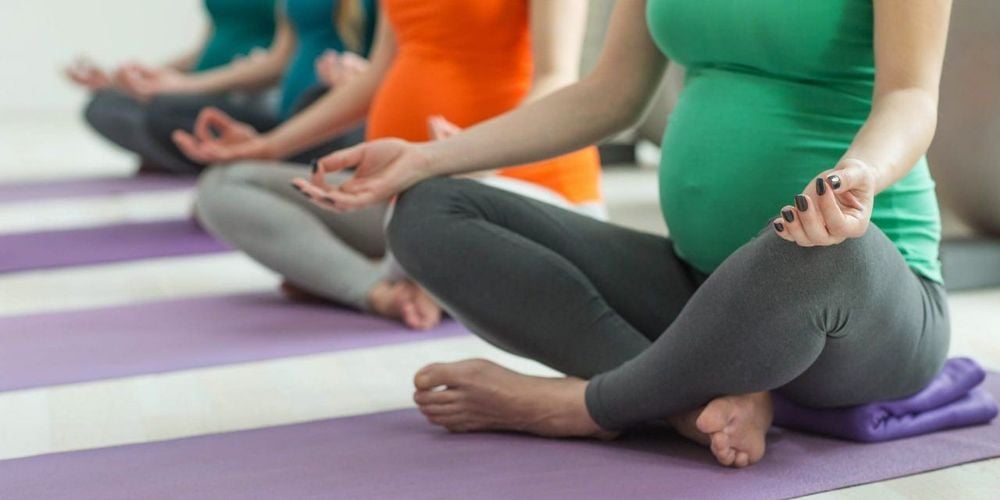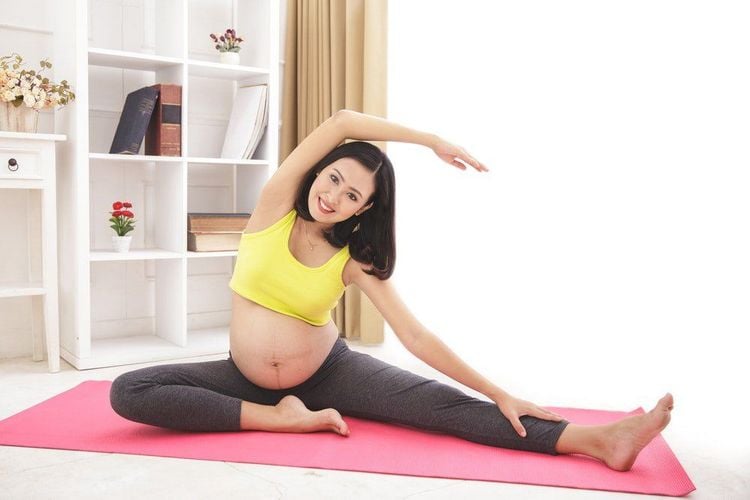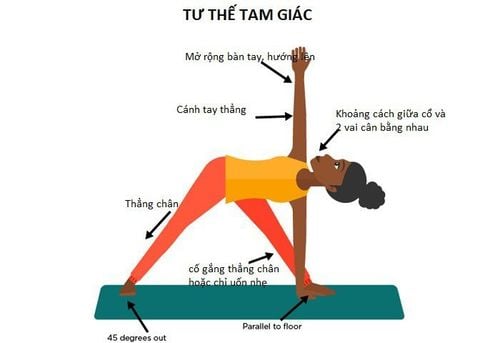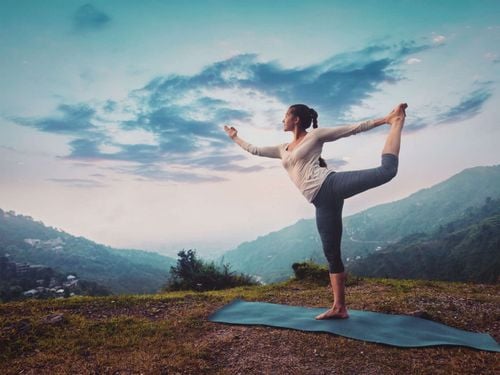This is an automatically translated article.
Performing yoga poses is a gentle way to keep your body active and supple and minimize common pregnancy symptoms like morning sickness and constipation. Yoga can also help ensure easier labor and a smooth delivery by reducing tension around the cervix. So which yoga poses are safe for pregnant women?1. Is it safe to practice yoga during pregnancy?
Pregnancy is a time of extreme emotions. One moment you will feel overjoyed, another moment you may cry for no reason. This is due to hormonal changes, you will experience morning sickness, nausea, fatigue, mood swings and in general, this period makes the body tired.As you enter the second trimester of pregnancy, your baby grows rapidly, and will put pressure on your uterus, back and spine. So be prepared to deal with back pain, cramps, and ankle swelling this trimester. While yoga cannot eliminate this pain completely, it can help you to alleviate it to some extent.
Yoga is very helpful for pregnant women. Practicing yoga can help prepare you mentally and physically for labor and delivery as it helps you focus and keeps you healthy. Additionally, yoga helps you adjust to the physical demands of pregnancy, labor, birth, and motherhood. It calms both mind and body, reducing the physical and emotional stress your body needs during pregnancy. Some positions can even help you feel less pain during labor and deliver your baby, or reduce the risk of a cesarean section.
However, there are principles that pregnant women need to follow when practicing yoga during pregnancy as follows:
If you are attending a yoga training class, your instructor needs to know that you are at this stage of pregnancy. How can you get the poses that work best for you? Do not practice any posture on your back after the first trimester, it can reduce blood flow to the uterus. Avoid poses that overstretch your muscles, especially crunches. You're more at risk of straining, pulling, and other injury right now because of the pregnancy hormone relaxin - a hormone that allows the uterus to expand and soften connective tissues.

Tập yoga có thể giúp bạn chuẩn bị tinh thần và cơ thể cho quá trình chuyển dạ và sinh nở vì điều này giúp bạn tập trung và giữ cho bạn khỏe mạnh

Khi thực hành các tư thế vặn người, hãy vặn nhiều hơn từ vai và lưng hơn là từ thắt lưng, để tránh gây áp lực lên bụng
2. Safe yoga poses for pregnant women
2.1. Mountain Pose (Tadasana) This yoga pose is usually done in the morning. If you do it after other poses, you need to do it on an empty stomach. Mountain pose improves blood circulation, improves posture and strengthens the thighs and legs, and it also effectively relieves back pain.Perform Stand up straight and bring your feet hip-width apart. While standing, your spine should be straight, your arms close to your body, and your palms facing your thighs. Inhale deeply, straighten your spine, and raise your arms above your head. Stretch your back and tilt your head back so you can look at your fingertips. Hold this position for 10-15 seconds, then exhale slowly and return to the normal position. 2.2. Triangle Pose (Trikonasana) This is a great pose for pregnant women to do during the third trimester of pregnancy. It helps widen your hips, which is very beneficial for your labor. Trikonasana strengthens thighs, knees, ankles, arms and chest, improves digestion during pregnancy. Trikonasana also stretches the hips, hamstrings, and groin. This pose can also be done after you have given birth.
Perform Stretch your feet wide. Now, inhale and straighten your arms from the sides up to your shoulder height. Keep them straight without bending away from the elbow. Then exhale and rotate the right foot 90 degrees outward and the left foot inward about 45 degrees. As you inhale, stand up straight and as you exhale, bend to the side from the waist and hold your right shin with your right hand. Keep your left arm straight toward the ceiling. Inhale and hold this pose for 30 seconds. Return to normal position using legs, thighs, and upper arms.

Tư thế tam giác (Trikonasana) là tư thế tuyệt vời dành cho các bà bầu thực hiện trong ba tháng giữ của thai kỳ
Perform Stand up straight with your feet and place your hands on either side of your body with your palms facing your thighs. Now spread your feet about three feet apart. Bend your right knee so that your knee and ankle are in a straight line. Increase the distance between your feet if required to make sure your right knee and right ankle are in a straight line. Gently raise your arms above your head. Touch your palm Hold this warrior pose for a moment, breathe normally, and return to the normal position. 2.4. Easy Pose (Sukhasana) This is a meditation pose, should be done in the morning, very good for beginners. It helps relax your mind and body, lengthens your knees, eyes and legs, and strengthens your back.
Perform Sit up straight on the yoga mat with your feet stretched out in front of you. Cross your legs in such a way that the knees are bent and each foot is below the knee. Then place your palms on top of your knees. Sit up straight; Your spine should be straight. Breathe normally and let your body relax. Stay in this position for 10-15 minutes. 2.5. Cat - Crawling Pose (Marjaryasana) Yoga poses should only be performed for the first six months and not longer. This pose strengthens the shoulders and wrists, improves blood circulation, tones the abdomen, and helps the body cope with the extra pregnancy weight.
Perform On the yoga mat, bend your knees and arms; Your back should be at the top of the table. Your knees should be hip-width apart; right arm perpendicular to the floor and palm touching the mat. Slowly inhale while lifting your chin and tilting your head back. Also, lower your spine so that your back is in a concave position. Hold this pose for several breaths; Exhale and drop your head and chin down while arching your back. Again, hold this position for a few seconds and return to the normal position.

Tư thế yoga này chỉ nên thực hiện trong sáu tháng đầu tiên và không kéo dài hơn
Execution
Stand up straight with your feet apart. Place your arms at your sides, palms facing your thighs. Slowly inhale and raise your arms overhead. Exhale and bend forward. Your hands should be behind your back and palms together. Hold this position for 15-30 seconds, then take a deep breath and return to the starting position. Perform 4-5 times of this asana. 2.7. Corpse Pose (Shavasana) This pose is usually done at the end of every workout. Shavasana relaxes your body and mind
Perform On a yoga mat, lie on your back and keep your legs in a relaxed position. After the first trimester, this asana can be done by lying on one side of the back. Close your eyes and place your arms along your body and palms facing up. Inhale and exhale slowly but deeply and let your body calm down. Stay in this position for 10 to 12 minutes, you will feel refreshed. Now comes the sitting position on the mat; close your eyes. Cover your face with your palm and gently massage the entire face with your palm. Please follow our website ( www.vinmec.com ) for more information on health care instructions, which we will update regularly.
Please dial HOTLINE for more information or register for an appointment HERE. Download MyVinmec app to make appointments faster and to manage your bookings easily.
Reference sources: babycenter.com, verywellfit.com, parenting.firstcry.com












